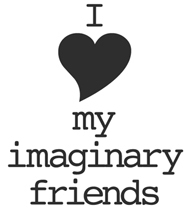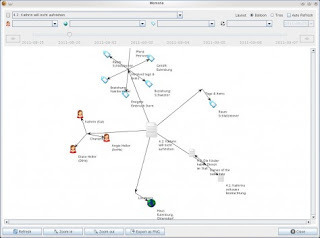Taking Control of my Imaginary Friends
 Since work on ExtraNormal is on hold while I wait on Eve's magical fingers to complete the cover, I've decided to shift gears for a while and get started on Book Two.
Since work on ExtraNormal is on hold while I wait on Eve's magical fingers to complete the cover, I've decided to shift gears for a while and get started on Book Two.I've never written a book two before, and I'm kind of excited. Mostly because I already know all the main characters. I'm counting on that meaning we don't have to spend as much time on introductions as we have in past novels.
When I started out as a young starry-eyed novelist, I opened a blank Word document (actually I can't even swear it was Word, might have been WordPress, but that's too painful to even think about so we'll move on.) Anyway, I opened a blank word processing document and started typing. I had the story mostly planned out in my head. At least I knew how I wanted it to start and end. The stuff in the middle was kind of vague. But I figured I'd worry about details when I got to them.
I typed along merrily, making up events and characters and such, until I started getting feedback like "I'm not buying that he would do that. Why would he do that?" And I'd want to say, "Cause I made it him do it. I created him!" But apparently that doesn't make for good story telling.
So then I'd have to go back and figure out if I should make my character do something different, or if I should change something in the story so that it would be logical to do what I want him to do.
Let me tell you, either way means a bunch of re-writing. You would not believe how many changes need to be made in a manuscript to change a main character's entire personality. So I've gotten smarter (that's what we're supposed to do, right?) with each manuscript, and planned more from the beginning. Though still not enough to not require major overhauls as I go along.
My biggest problem with outlining (besides the fact that it's tedious and boring) is that I tend to plot out what I want to have happen, but not how each character is going to feel about each event. (Otherwise known as their "motivations" and "reactions" but I'm not being technical here.)
So as an example, I can have a scene where my main character is almost kidnapped followed by her going on a hot date, cause that how it worked in my outline. But really? What girl is going to go on a date just after someone tries to grab her on the street? Even if he is a hottie? Okay, maybe she'd go, but she'd be a wreck and all crying and blowing her nose.
I know it sounds stupid, but when you're just outlining one scene after another, it can happen, believe me.
Sometimes my problem is with a character I didn't realize was going to be in a scene until I write it.
For instance, there's a scene in ExtraNormal where two main characters have a big fight. It's a great scene, and Mira is all angry and up-in-your face with the guy she hates. And the guy she hates is all haughty and snobby and you just want to punch him. I loved the scene. It was perfect.
And then I realized that Mira's dad was watching. He just happened to be there from the scene before and I hadn't given him any reason to leave. I also realized that he hadn't been given enough info to understand that fight, and that he would interpret it entirely wrong. So I wrote that in. Which totally rocked Mira's world, and changed the story--for the better. And here's a funny bit of trivia: when Mira is slapping her forehead going "I never even thought of that," about what her dad says, she's mimicking me. Because I hadn't thought of it until that moment either. And it was all good. In fact, it was one of my favorite parts of writing the story. It just would have been nice if I'd thought of it earlier.
So this time I'm trying something new, and I'm super excited. Instead of a basic spreadsheet like I've used before for the outline, I've decided to try story-writing software. There are lots of them out there and I can't pretend to know enough comment on any of them. Except that I chose this one called StoryBook. And while it has lots of nifty features, honestly the one that put it over the top for me was this little flow chart:

Isn't that adorable? I read through the tutorial yesterday and learned that as you write your scenes you list who is where in the scene and what tools they have and what they're feeling at the moment. And then you can pick any moment in time in your story and learn that while Professor Plum is in the parlor with the rope feeling scared, Misses Peacock is in the library with the candlestick and she's mad! Awesome!
Now I won't have any of my imaginary friends sneaking into scenes feeling all giddy when the mood is dark, or being all mean and selfish when they've been totally nice before.
Of course the tool is only as good as the person using it, and I tend to rush off without using my tools. But we'll see. I'm gonna try it. Right now it feels like a video game, so I'm hoping that will help me stick with it.
I'm curious to know what outlining (or imaginary friend taming) tools other authors have used, and if they've found them successful.
And hopefully by next week I'll have some news on that cover!
Published on February 09, 2012 10:18
No comments have been added yet.



